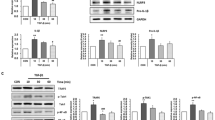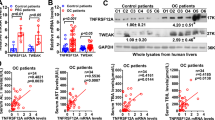Abstract
NLRP3 inflammasome-driven inflammation represents a key trigger for hepatic fibrogenesis during cholestatic liver injury. However, whether sphingosine 1-phosphate (S1P) plays a role in NLRP3 inflammasome priming and activation remains unknown. Here, we found that the expression of NLRP3 in macrophages and NLRP3 inflammasome activation were significantly elevated in the liver injured by bile duct ligation (BDL). In vitro, S1P promoted the NLRP3 inflammasome priming and activation via S1P receptor 2 (S1PR2) in bone marrow–derived monocyte/macrophages (BMMs). Focusing on BMMs, the gene silencing of Gα12 or Gα13 by specific siRNA suppressed NLRP3 inflammasome priming and pro-inflammatory cytokine (IL-1β and IL-18) secretion, whereas Gα(i/o) and Gαq were not involved in this process. The MAPK signaling pathways (P38, ERK, and JNK) mediated NLRP3 inflammasome priming and IL-1β and IL-18 secretion, whereas blockage of PI3K, ROCK, and Rho family had no such effect. Moreover, JTE-013 (S1PR2 inhibitor) treatment markedly reduced NLRP3 inflammasome priming and activation in BDL-injured liver. Collectively, S1P promotes NLRP3 inflammasome priming and pro-inflammatory cytokines (IL-1β and IL-18) secretion via the S1PR2/Gα(12/13)/MAPK pathway, which may represent an effective therapeutic strategy for liver disease.
Key message
• Hepatic NLRP3 expression was significantly elevated in BMMs of BDL-injured mouse liver.
• S1P promoted NLRP3 inflammasome priming and activation in BMMs, depending on the S1PR2/Gα(12/13)/MAPK pathway.
• Blockade of S1PR2 by JTE-013 reduced NLRP3 inflammasome priming and activation inflammasome in vivo.









Similar content being viewed by others
Data availability
Not applicable.
References
Li Y, Tang R, Leung PSC, Gershwin ME, Ma X (2017) Bile acids and intestinal microbiota in autoimmune cholestatic liver diseases. Autoimmun Rev 16(9):885–896
Vilas-Boas V, Gijbels E, Jonckheer J, De Waele E, Vinken M (2020) Cholestatic liver injury induced by food additives, dietary supplements and parenteral nutrition. Environ Int 136:105422
Woolbright BL (2020) Inflammation: cause or consequence of chronic cholestatic liver injury. Food Chem Toxicol 137:111133
Gomez-Munoz A, Presa N, Gomez-Larrauri A, Rivera IG, Trueba M, Ordonez M (2016) Control of inflammatory responses by ceramide, sphingosine 1-phosphate and ceramide 1-phosphate. Prog Lipid Res 61:51–62
Fyrst H, Saba JD (2010) An update on sphingosine-1-phosphate and other sphingolipid mediators. Nat Chem Biol 6(7):489–497
Ksiazek M, Chacinska M, Chabowski A, Baranowski M (2015) Sources, metabolism, and regulation of circulating sphingosine-1-phosphate. J Lipid Res 56(7):1271–1281
Bryan AM, Del Poeta M (2018) Sphingosine-1-phosphate receptors and innate immunity. Cell Microbiol 20(5):e12836
Li C, Zheng S, You H, Liu X, Lin M, Yang L, Li L (2011) Sphingosine 1-phosphate (S1P)/S1P receptors are involved in human liver fibrosis by action on hepatic myofibroblasts motility. J Hepatol 54(6):1205–1213
Yang L, Yue S, Yang L, Liu X, Han Z, Zhang Y, Li L (2013) Sphingosine kinase/sphingosine 1-phosphate (S1P)/S1P receptor axis is involved in liver fibrosis-associated angiogenesis. J Hepatol 59(1):114–123
Zhao S, Adebiyi MG, Zhang Y, Couturier JP, Fan X, Zhang H, Kellems RE, Lewis DE, Xia Y (2018) Sphingosine-1-phosphate receptor 1 mediates elevated IL-6 signaling to promote chronic inflammation and multitissue damage in sickle cell disease. FASEB J 32(5):2855–2865
Gaire BP, Song MR, Choi JW (2018) Sphingosine 1-phosphate receptor subtype 3 (S1P3) contributes to brain injury after transient focal cerebral ischemia via modulating microglial activation and their M1 polarization. J Neuroinflammation 15(1):284
Yang L, Han Z, Tian L, Mai P, Zhang Y, Wang L, Li L (2015) Sphingosine 1-phosphate receptor 2 and 3 mediate bone marrow-derived monocyte/macrophage motility in cholestatic liver injury in mice. Sci Rep 5:13423
Yang J, Yang L, Tian L, Ji X, Yang L, Li L (2018) Sphingosine 1-phosphate (S1P)/S1P receptor2/3 axis promotes inflammatory M1 polarization of bone marrow-derived monocyte/macrophage via G(alpha)i/o/PI3K/JNK pathway. Cell Physiol Biochem 49(5):1677–1693
Mantovani A, Dinarello CA, Molgora M, Garlanda C (2019) Interleukin-1 and related cytokines in the regulation of inflammation and immunity. Immunity 50(4):778–795
Szabo G, Csak T (2012) Inflammasomes in liver diseases. J Hepatol 57(3):642–654
El Kasmi KC, Vue PM, Anderson AL, Devereaux MW, Ghosh S, Balasubramaniyan N, Fillon SA, Dahrenmoeller C, Allawzi A, Woods C, McKenna S, Wright CJ, Johnson L, D'Alessandro A, Reisz JA, Nozik-Grayck E, Suchy FJ, Sokol RJ (2018) Macrophage-derived IL-1β/NF-κB signaling mediates parenteral nutrition-associated cholestasis. Nat Commun 9(1):1393
Meier RPH, Meyer J, Montanari E, Lacotte S, Balaphas A, Muller YD, Clément S, Negro F, Toso C, Morel P, Buhler LH (2019) Interleukin-1 receptor antagonist modulates liver inflammation and fibrosis in mice in a model-dependent manner. Int J Mol Sci 20(6). https://doi.org/10.3390/ijms20061295
Awad F, Assrawi E, Louvrier C, Jumeau C, Georgin-Lavialle S, Grateau G, Amselem S, Giurgea I, Karabina SA (2018) Inflammasome biology, molecular pathology and therapeutic implications. Pharmacol Ther 187:133–149
Mridha AR, Wree A, Robertson AAB, Yeh MM, Johnson CD, Van Rooyen DM, Haczeyni F, Teoh NC, Savard C, Ioannou GN, Masters SL, Schroder K, Cooper MA, Feldstein AE, Farrell GC (2017) NLRP3 inflammasome blockade reduces liver inflammation and fibrosis in experimental NASH in mice. J Hepatol 66(5):1037–1046
Cai SY, Ge M, Mennone A, Hoque R, Ouyang X, Boyer JL (2020) Inflammasome is activated in the liver of Cholestatic patients and aggravates hepatic injury in bile duct-ligated mouse. Cell Mol Gastroenterol Hepatol 9(4):679–688
Ning ZW, Luo XY, Wang GZ, Li Y, Pan MX, Yang RQ, Ling XG, Huang S, Ma XX, Jin SY, Wang D, Li X (2017) MicroRNA-21 mediates angiotensin II-induced liver fibrosis by activating NLRP3 inflammasome/IL-1β Axis via targeting Smad7 and Spry1. Antioxid Redox Signal 27(1):1–20
Wree A, McGeough MD, Pena CA, Schlattjan M, Li H, Inzaugarat ME, Messer K, Canbay A, Hoffman HM, Feldstein AE (2014) NLRP3 inflammasome activation is required for fibrosis development in NAFLD. J Mol Med (Berlin, Germany) 92(10):1069–1082
Jin Y, Li C, Xu D, Zhu J, Wei S, Zhong A, Sheng M, Duarte S, Coito AJ, Busuttil RW, Xia Q, Kupiec-Weglinski JW, Ke B (2019) Jagged1-mediated myeloid Notch1 signaling activates HSF1/snail and controls NLRP3 inflammasome activation in liver inflammatory injury. Cell Mol Immunol 17:1245–1256
Zhang S, Jiang L, Hu H, Wang H, Wang X, Jiang J, Ma Y, Yang J, Hou Y, Xie D, Zhang Q (2020) Pretreatment of exosomes derived from hUCMSCs with TNF-alpha ameliorates acute liver failure by inhibiting the activation of NLRP3 in macrophage. Life Sci 246:117401
Zhang WJ, Fang ZM, Liu WQ (2019) NLRP3 inflammasome activation from Kupffer cells is involved in liver fibrosis of Schistosoma japonicum-infected mice via NF-kappaB. Parasit Vectors 12(1):29
Li C, Kong Y, Wang H, Wang S, Yu H, Liu X, Yang L, Jiang X, Li L, Li L (2009) Homing of bone marrow mesenchymal stem cells mediated by sphingosine 1-phosphate contributes to liver fibrosis. J Hepatol 50(6):1174–1183
Tilg H, Moschen AR, Szabo G (2016) Interleukin-1 and inflammasomes in alcoholic liver disease/acute alcoholic hepatitis and nonalcoholic fatty liver disease/nonalcoholic steatohepatitis. Hepatology (Baltimore, Md) 64(3):955–965
Luan J, Ju D (2018) Inflammasome: a double-edged sword in liver diseases. Front Immunol 9:2201
Boaru SG, Borkham-Kamphorst E, Tihaa L, Haas U, Weiskirchen R (2012) Expression analysis of inflammasomes in experimental models of inflammatory and fibrotic liver disease. J Inflamm (London, England) 9(1):49
van der Heide D, Weiskirchen R, Bansal R (2019) Therapeutic targeting of hepatic macrophages for the treatment of liver diseases. Front Immunol 10:2852
Tacke F (2017) Targeting hepatic macrophages to treat liver diseases. J Hepatol 66(6):1300–1312
Takabe K, Paugh SW, Milstien S, Spiegel S (2008) “Inside-out” signaling of sphingosine-1-phosphate: therapeutic targets. Pharmacol Rev 60(2):181–195
Alyaseer AAA, de Lima MHS, Braga TT (2020) The role of NLRP3 inflammasome activation in the epithelial to mesenchymal transition process during the fibrosis. Front Immunol 11:883
McMillin M, Frampton G, Grant S, Khan S, Diocares J, Petrescu A, Wyatt A, Kain J, Jefferson B, DeMorrow S (2017) Bile acid-mediated sphingosine-1-phosphate receptor 2 signaling promotes neuroinflammation during hepatic encephalopathy in mice. Front Cell Neurosci 11:191
Zhao S, Gong Z, Du X, Tian C, Wang L, Zhou J, Xu C, Chen Y, Cai W, Wu J (2018) Deoxycholic acid-mediated sphingosine-1-phosphate receptor 2 signaling exacerbates DSS-induced colitis through promoting cathepsin B release. J Immunol Res 2018:2481418
Yan T, Wang H, Cao L, Wang Q, Takahashi S, Yagai T, Li G, Krausz KW, Wang G, Gonzalez FJ, Hao H (2018) Glycyrrhizin alleviates nonalcoholic Steatohepatitis via modulating bile acids and meta-inflammation. Drug Metab Dispos 46(9):1310–1319
Weichand B, Popp R, Dziumbla S, Mora J, Strack E, Elwakeel E, Frank AC, Scholich K, Pierre S, Syed SN, Olesch C, Ringleb J, Oren B, Doring C, Savai R, Jung M, von Knethen A, Levkau B, Fleming I, Weigert A, Brune B (2017) S1PR1 on tumor-associated macrophages promotes lymphangiogenesis and metastasis via NLRP3/IL-1beta. J Exp Med 214(9):2695–2713
Gu JL, Muller S, Mancino V, Offermanns S, Simon MI (2002) Interaction of G alpha(12) with G alpha(13) and G alpha(q) signaling pathways. Proc Natl Acad Sci U S A 99(14):9352–9357
Kim KM, Han CY, Kim JY, Cho SS, Kim YS, Koo JH, Lee JM, Lim SC, Kang KW, Kim JS, Hwang SJ, Ki SH, Kim SG (2018) Galpha12 overexpression induced by miR-16 dysregulation contributes to liver fibrosis by promoting autophagy in hepatic stellate cells. J Hepatol 68(3):493–504
Kaffe E, Katsifa A, Xylourgidis N, Ninou I, Zannikou M, Harokopos V, Foka P, Dimitriadis A, Evangelou K, Moulas AN, Georgopoulou U, Gorgoulis VG, Dalekos GN, Aidinis V (2017) Hepatocyte autotaxin expression promotes liver fibrosis and cancer. Hepatology (Baltimore, Md) 65(4):1369–1383
Bataller R, Sancho-Bru P, Gines P, Lora JM, Al-Garawi A, Sole M, Colmenero J, Nicolas JM, Jimenez W, Weich N, Gutierrez-Ramos JC, Arroyo V, Rodes J (2003) Activated human hepatic stellate cells express the renin-angiotensin system and synthesize angiotensin II. Gastroenterology 125(1):117–125
Wang C, Hockerman S, Jacobsen EJ, Alippe Y, Selness SR, Hope HR, Hirsch JL, Mnich SJ, Saabye MJ, Hood WF, Bonar SL, Abu-Amer Y, Haimovich A, Hoffman HM, Monahan JB, Mbalaviele G (2018) Selective inhibition of the p38alpha MAPK-MK2 axis inhibits inflammatory cues including inflammasome priming signals. J Exp Med 215(5):1315–1325
Li Z, Zhao F, Cao Y, Zhang J, Shi P, Sun X, Zhang F, Tong L (2018) DHA attenuates hepatic ischemia reperfusion injury by inhibiting pyroptosis and activating PI3K/Akt pathway. Eur J Pharmacol 835:1–10
Song N, Liu ZS, Xue W, Bai ZF, Wang QY, Dai J, Liu X, Huang YJ, Cai H, Zhan XY, Han QY, Wang H, Chen Y, Li HY, Li AL, Zhang XM, Zhou T, Li T (2017) NLRP3 phosphorylation is an essential priming event for inflammasome activation. Mol Cell 68(1):185–197.e186
Wang F, Okamoto Y, Inoki I, Yoshioka K, Du W, Qi X, Takuwa N, Gonda K, Yamamoto Y, Ohkawa R, Nishiuchi T, Sugimoto N, Yatomi Y, Mitsumori K, Asano M, Kinoshita M, Takuwa Y (2010) Sphingosine-1-phosphate receptor-2 deficiency leads to inhibition of macrophage proinflammatory activities and atherosclerosis in apoE-deficient mice. J Clin Invest 120(11):3979–3995
Funding
This work was supported by grants from the National Natural and Science Foundation of China (81970532, 81770603).
Author information
Authors and Affiliations
Contributions
Conceptualization, Liying Li; Methodology, Lei Hou; Funding acquisition, Liying Li and Na Chang; Formal analysis, Lei Hou; Investigation, Lei Hou, Zhi Zhang, Xinhao Zhao. and Xuan Zhou; Writing-original draft preparation, Lei Hou, Le Yang, and Na Chang; Writing-review and editing, Liying Li; project administration, Lin Yang. All authors commented on previous versions of the manuscript. All authors read and approved the final manuscript.
Corresponding author
Ethics declarations
Conflict of interest
The authors declare that they have no conflicts of interest.
Ethics approval
All animal work conformed to the Ethics Committee of Capital Medical University and were in accordance with the approved guidelines (approval AEEI-2014-131).
Consent to participate
Not applicable.
Consent for publication
Not applicable.
Additional information
Publisher’s note
Springer Nature remains neutral with regard to jurisdictional claims in published maps and institutional affiliations.
Supplementary information
ESM 1
(PDF 235 kb)
Rights and permissions
About this article
Cite this article
Hou, L., Zhang, Z., Yang, L. et al. NLRP3 inflammasome priming and activation in cholestatic liver injury via the sphingosine 1-phosphate/S1P receptor 2/Gα(12/13)/MAPK signaling pathway. J Mol Med 99, 273–288 (2021). https://doi.org/10.1007/s00109-020-02032-4
Received:
Revised:
Accepted:
Published:
Issue Date:
DOI: https://doi.org/10.1007/s00109-020-02032-4




